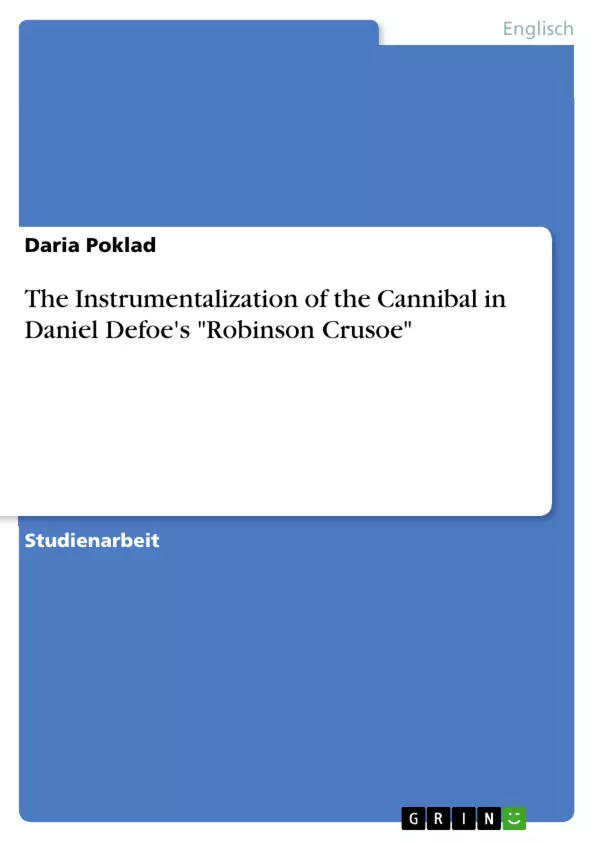Daniel Defoe’s novel "Robinson Crusoe" (1719) revolves around the Englishman Robinson Crusoe, who, after suffering shipwreck in a storm strands on a deserted island as the sole survivor of an expedition. After twenty-four of his total twenty-eight years on the island he discovers that native cannibals occasionally visit the island in order to kill and eat their captives. When Crusoe rescues one of them the captive is grateful and stays with Crusoe as his servant. Crusoe names him Friday after the day of their first encounter and teaches him the English language and eventually converts him to Christianity.
"Robinson Crusoe" is considered a classic which has been issued in at least 700 editions and translated into several languages. The story has been made into several movies.
I want to argue, that the motif of the cannibal is instrumentalized in the novel in order to justify the conquering and civilizing of savage natives by the dominant Western world. By depicting dreadful cannibalistic acts and evoking horror and revulsion the subjects of colonialism are intended to be dehumanized. I will begin the seminar paper with a contextual chapter on cannibalism by presenting the definition and origin of the term ‘cannibal’, as well as the existence of cannibalism in literature by giving various examples from classic epic to contemporary novels. Then, I will focus on Defoe’s Robinson Crusoe and illustrate the protagonist’s constant fear of being eaten. In a next step, I will focus on Crusoe’s encounters with the cannibals and in a further step on his meeting of Friday and his representation of the latter. Before drawing the conclusion, I will analyze the relationship between Crusoe and Friday.
Table of Contents
- Introduction
- Cannibalism
- Definition and Origin of the Term ‘Cannibal’
- Cannibalism in Literature
- Robinson Crusoe's Fear of Being Eaten
- Crusoe's Encounters with the Cannibals
- The Representation of Friday
- The Relationship between Crusoe and Friday
Objectives and Key Themes
Die Seminararbeit analysiert die Darstellung von Kannibalismus in Daniel Defoes Roman Robinson Crusoe (1719) und argumentiert, dass das Motiv des Kannibalen dazu dient, die Eroberung und Zivilisierung wilder Eingeborener durch die dominierende westliche Welt zu rechtfertigen.
- Definition und historische Kontexte des Begriffs 'Kannibalismus'
- Darstellung von Kannibalismus in der Literatur
- Robinson Crusoes Angst vor dem Gegessenwerden
- Crusoes Begegnungen mit den Kannibalen
- Die Beziehung zwischen Crusoe und Freitag
Chapter Summaries
- Das erste Kapitel beleuchtet die Definition und den Ursprung des Begriffs 'Kannibalismus' und untersucht die Verwendung des Motivs in der Literatur.
- Das zweite Kapitel untersucht Robinson Crusoes ständige Angst vor dem Gegessenwerden durch die Kannibalen.
- Das dritte Kapitel fokussiert sich auf Crusoes Begegnungen mit den Kannibalen auf der Insel.
- Das vierte Kapitel analysiert die Darstellung von Freitag, dem geretteten Kannibalen, und sein Verhältnis zu Crusoe.
- Das fünfte Kapitel betrachtet die Beziehung zwischen Crusoe und Freitag und zeigt, wie sich diese im Laufe der Zeit entwickelt.
Keywords
Schlüsselbegriffe dieser Arbeit sind Kannibalismus, Kolonialismus, Zivilisation, Primitivismus, Robinson Crusoe, Daniel Defoe, Friday, Anthropophagie, Stereotypisierung, Der Wilde, Kultur und Rassismus.
- Quote paper
- Daria Poklad (Author), 2016, The Instrumentalization of the Cannibal in Daniel Defoe's "Robinson Crusoe", Munich, GRIN Verlag, https://www.grin.com/document/353022



